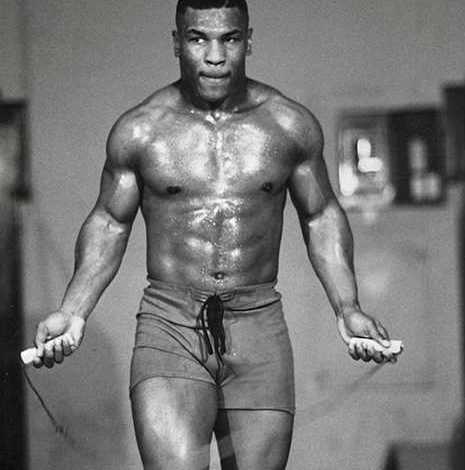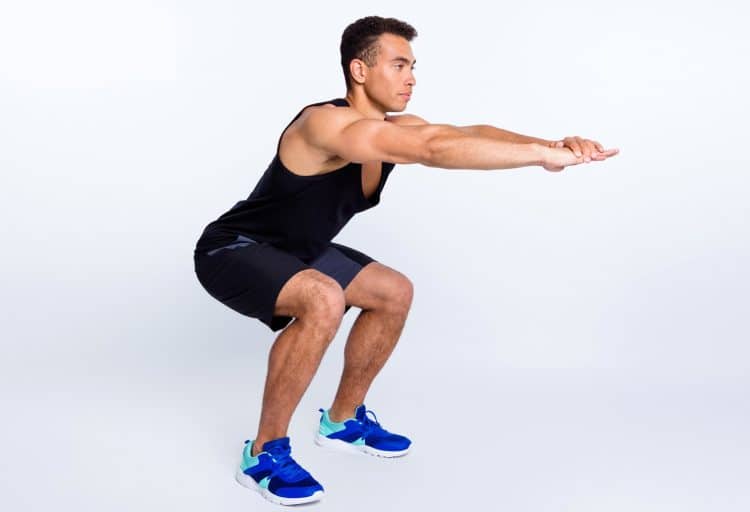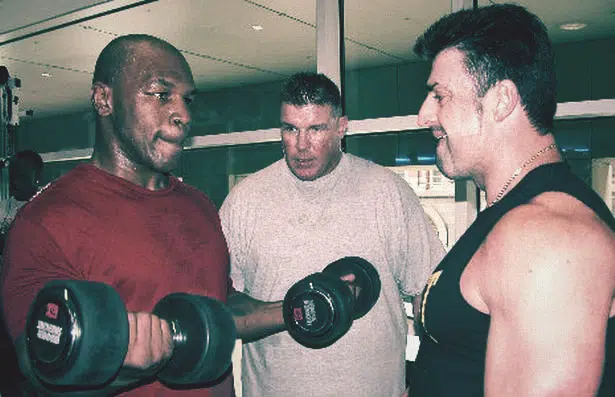Love him or hate him, you cannot ignore Mike Tyson.
Tyson, the youngest man to ever win a heavyweight title (at age 20 in 1986), retired in 2005. However, he has since fought several exhibition matches. The 58-year-old Tyson is set to fight 27-year-old Jake Paul on November 15, 2024.
“Iron Mike” has one of the most intense training regimes ever, and experts believe his legendary conditioning played a crucial role in his boxing career success.
The most mind-boggling part about Tyson’s training routine was that he hardly ever used any fancy equipment. Iron Mike mainly relied on calisthenic exercises to build strength and improve his endurance and conditioning.
In this article, I take you over the exact training routine that forged Tyson into one of the most formidable boxers and how to scale it to match your current fitness level.
Mike Tyson’s Legendary Training Circuit
Level Up Your Fitness: Join our 💪 strong community in Fitness Volt Newsletter. Get daily inspiration, expert-backed workouts, nutrition tips, the latest in strength sports, and the support you need to reach your goals. Subscribe for free!
Training for each sport varies a lot. While some athletes, like football players, might focus on lifting heavy weights to get strong and jacked, combat athletes prioritize speed and agility over muscle mass and mainly rely on bodyweight workouts to achieve their fitness objectives.
Tyson kept his workout pretty straightforward. Before we delve into his training regime, let’s look at his daily schedule.
| Time | Activity |
| 4:00 AM | Stretching |
| 4:30 AM | Steady 3-5 mile run + a few miles walking |
| 12:00 PM | Sparring and skills work (mitts, pads, slip bag) |
| 1:00 PM | Calisthenics workout |
| 3:00 PM | Boxing skills work and heavy bag work |
| 3:30 PM | Jump rope and calisthenics |
| 5:00 PM | Calisthenics workout |
| 9:00 PM | Active recovery cardio (indoor bike) |
While most people have a particular part of their day dedicated to training, Tyson had to make time for life outside the gym. What’s even crazier is that Tyson would clock upwards of 50 hours a week when training for a fight — that’s over seven hours a day! (1)
This tells you something about his dedication and commitment to becoming the best at his craft.
I don’t know about you, but I’m exhausted just reading about his daily schedule.
Mike Tyson’s Bodyweight Circuit Workout
Tyson did notoriously exhausting calisthenics workouts to boost his anaerobic and aerobic stamina and endurance, strength, and get in shape for his fights. Furthermore, his training program was strategically put together to target each muscle group, ensuring overall development.
His bodyweight workouts primarily comprised five exercises:
1. Push-Ups
This exercise biases your chest, shoulders, and triceps and helps build upper body strength to generate that explosive punching power.
How to Perform Push-Ups:
- Kneel on the floor.
- Place your hands wider than shoulder-width apart on the floor.
- Get into a high plank position. Make sure your wrist and shoulders are aligned.
- Flex your elbows and lower your body until your chest gently touches the floor.
- Return to the starting position.
Coach Tip: Use as much force as possible during the concentric phase to maximize upper body strength.
2. Sit-Ups
Sit-ups are a non-negotiable for boxers as they are essential for core strength and stability. Furthermore, a strong core can maximize power generation while throwing punches.
How to Perform Sit-Ups:
- Lie supine on the floor.
- Flex your knees, and place your feet flat on the floor.
- Hold your hands against your ears.
- Contract your abs and lift your upper body off the floor until you’re sitting upright.
- Slowly, lower to the starting position.
- Repeat for recommended reps.
Coach Tip: As you gain more experience, perform twisting crunches to maximize oblique and serratus anterior engagement. This will help in the overall development of your midline.
3. Squats
The king of lower body exercise, squats help build overall lower body strength and explosive power, which is essential for boxers who must stay agile throughout a boxing match.
How to Perform Squats:
- Stand upright with a shoulder-width stance.
- While maintaining a proud chest, squat as low as your mobility allows.
- Your knees should be bent at least 90 degrees at the bottom of the range of motion.
- Extend your ankles, knees, and hips to return to the starting position.
Coach Tip: Aim for slow, controlled negatives to maximize target muscle stimulation and growth. (3)
4. Dips
This exercise targets the triceps and chest, and you can perform them on parallel bars or a bench. We’ll take the bench variation for the sake of this tutorial.
How to Perform Dips:
- Sit down on a bench with your hands next to your thighs.
- Walk your feet out and extend your legs. Lift your bottom off the bench.
- Flex your elbows and lower your body as far as you can toward the floor. Aim for at least a 90-degree bottom position.
- Push up through your palms to return to the starting position.
Coach Tip: Make this exercise more changing by inching your feet out every week.
5. Jump Rope
Jump ropes are a staple in most boxing training regimes. They are excellent for building cardiovascular endurance and stamina, and they also target the lower body, shoulders, arms, and core.
How to Perform Jump Rope:
- Hold the robot, keeping your hands at hip level.
- Rotate your wrist to swing the rope.
- Jump with both feet at the same time to skip over the rope.
- Repeat for the recommended time or reps.
Coach Tip: Double and triple under are more challenging jump rope variations that will lead to greater muscle stimulation and adaptations.
Mike Tyson’s Intense Training Regime
For those craving a challenge, here is Tyson’s exact training routine:
- Begin with a 3-mile run
- Calisthenics routine for time:
- Bodyweight Squats: 2000
- Sit Ups: 2500
- Push Ups: 500
- Bench Dips: 500
- Jump rope: 5 x 1-minute
While some say that Tyson did all this work in a single workout, others argue that he split it up into multiple sessions throughout the day. Whatever it might be, so much training volume throughout the week will make you indestructible.
Remember, while all these are bodyweight exercises, you must invest five to 10 minutes before each workout to warm up the target muscles. This can help boost training performance while limiting the possibility of getting hurt.
Adapting Tyson’s Training Circuit For Varying Experience Levels
Body weight exercises are especially great as they can help maximize muscle tissue stimulation while minimizing injury risk (2). This could also be one of the biggest reasons Tyson used calisthenics exercises to prep for a fight. After all, who wants to get injured before a big payday?
I would suggest only advanced athletes try Tyson’s original training routine. Others must scale it to maximize their results and stay injury-free.
Level Up Your Fitness: Join our 💪 strong community in Fitness Volt Newsletter. Get daily inspiration, expert-backed workouts, nutrition tips, the latest in strength sports, and the support you need to reach your goals. Subscribe for free!
“Everyone has a plan until they get punched in the mouth,” said Mike Tyson. This is exactly what happens when you try to emulate Tyson’s training regime with zero preparation.
Scaled-Down Workout For Beginners
This is how beginners can modify Tyson’s training regime:
Complete five rounds of:
| Exercise | Repetitions |
| Air Squats | 20 |
| Sit Ups | 25 |
| Push Ups | 5 |
| Bench Dips | 5 |
This is followed by 100 rope skips.
You see what we did here?
We just removed the two zeroes from every exercise. This simple technique makes Tyson’s training regime much more manageable for most people.
In other words, you’ll only be doing one percent of Tyson’s original training volume in each set.
Yup, that’s how most of us stack up against Iron Mike.
If you are a beginner, this training routine is incredibly effective for building a solid foundation for speed, endurance, and muscle mass.
Intermediate Exercisers
Once you’re comfortable with the beginner scaled-down Tyson routine, it’s time to ramp things up. Remember, this isn’t just a small hike in training volume. You did a total of 275 reps in the beginner variation. You’ll be taking this up to 2,750 reps at this level.
This is how you will do it. Complete five rounds of:
| Exercise | Repetitions |
| Air Squats | 200 |
| Sit Ups | 250 |
| Push Ups | 50 |
| Bench Dips | 50 |
Feel free to take five to 10 minutes of rest between each round.
Remember, progressive overload is the name of the game when it comes to making gains in the gym. You can achieve this by increasing the number of sets and reps, decreasing the rest time between sets, or adding resistance.
Learn to listen to your body. If something feels weird or uncomfortable, pull the plug on the workout immediately. Take an extra day off from training if you feel beat up. That is your body telling you that you need more time to recover.
Tyson’s Training Philosophy
Tyson’s training routine will help you get fast, strong, and intimidating. The best part about this training regime is that you can perform it anywhere, at any time, since it doesn’t require any equipment.
Here are the main principles behind his unique training approach:
High-Volume, High-Intensity: The Cornerstone of Conditioning
How many of us can imagine doing 2,000 squats, 2,500 sit-ups, 500 push-ups, and 500 dips all in one day? But that’s a typical day at the office for Tyson.
This high-volume, high-intensity training approach was the secret behind Tyson‘s ultimate conditioning.
He pushed his body to the limit day in and day out, which helped him forge incredible strength, stamina, and endurance.
Even if you cannot do Tyson’s typical workout, you must stay consistent with the scaled-down routine.
Mental Fortitude: The Champion’s Mindset
True strength comes from within.
Look at any elite competitor, and you’ll realize that mental fortitude is just as important as physical capabilities. Tyson’s brutal regime helped him build a killer mindset. When you are doing 5,500 reps every day, you’ll start to believe that you can take down the most fierce competitors.
Explosive Power and Relentless Endurance: The Dynamic Duo
Tyson’s training regime isn’t only about brutal strength. I’ll help you with explosive power and endurance. His workouts primarily focused on engaging and developing fast-twitch muscle fibers through plyometrics and explosive movements that help generate knockout power.
Tyson’s long and grueling workouts ensured he could stay light and maintain a relentless pace throughout a fight.
Conclusion
To get “The Baddest Man on the Planet” strong, you must train like him. This high-intensity training regime is as effective for people who work out at a training facility as it is for those who train at home.
If Tyson can build his legendary knockout power, endurance, and stamina using bodyweight exercises, so can you. Pick the right training programming according to your current fitness level and stay consistent and disciplined. Stick with this training routine for at least eight weeks, and the results will follow.
If you have any questions about Tyson’s bodyweight circuit workouts or need help implementing them in your own workouts, post them in the comments below, and I’ll be happy to help!
References:
- Atakan MM, Li Y, Koşar ŞN, Turnagöl HH, Yan X. Evidence-Based Effects of High-Intensity Interval Training on Exercise Capacity and Health: A Review with Historical Perspective. Int J Environ Res Public Health. 2021 Jul 5;18(13):7201. doi: 10.3390/ijerph18137201. PMID: 34281138; PMCID: PMC8294064.
- Hertel G, Hochrein A, Suren C, Minzlaff P, Banke IJ, Willers J, von Eisenhart-Rothe R, Prodinger PM. Injury incidence and specific injury patterns in app-based bodyweight training (Freeletics): results of an international survey with 3668 participants. BMC Sports Sci Med Rehabil. 2022 Jul 26;14(1):145. doi: 10.1186/s13102-022-00525-y. PMID: 35883184; PMCID: PMC9321304.
- Burd NA, Andrews RJ, West DW, Little JP, Cochran AJ, Hector AJ, Cashaback JG, Gibala MJ, Potvin JR, Baker SK, Phillips SM. Muscle time under tension during resistance exercise stimulates differential muscle protein sub-fractional synthetic responses in men. J Physiol. 2012 Jan 15;590(2):351-62. doi: 10.1113/jphysiol.2011.221200. Epub 2011 Nov 21. PMID: 22106173; PMCID: PMC3285070.












